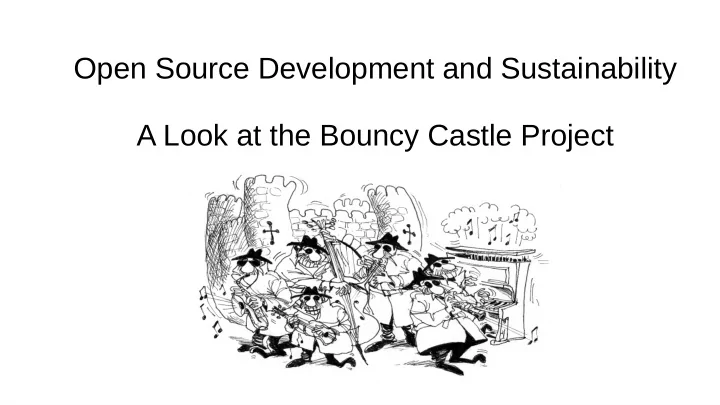

Open Source Development and Sustainability A Look at the Bouncy Castle Project
How It Started
Early Days ● Started with a low level API as one of us was playing around with the J2ME, built a provider on top of it. ● Added functionality for generating X.509 certificates. ● Then, of course, CRLs. ● Over the next couple of years, a few more algorithms (e.g. Elliptic Curve), improvements and additions (PKCS#12 support), and then...
Really Up and Running
More Features! ● Support for Cryptographic Message Syntax ● Support for Time Stamp Protocol ● Support for OpenPGP ● Attribute certificates ● A broader range of standards (paddings, algorithms) ● And more! But...
Suddenly, There is Complexity
And Realisation ● It's no longer just something you put on the Internet because you found it useful and thought someone else might. ● People are actually relying on it. ● You even find out your bank is relying on it! ● Reviewing the situation in this light, one rapidly realises that as good as everything is, it's one step from...
Chaos and Disaster
Principal Constraint - Time ● The issue isn't really ever money – it's actually time. ● Money does help free time up but is not a solution in itself. ● Lack of time can result in poor, or incomplete, test coverage, hasty check-ins, incomplete functionality. ● Favourite brother to “lack of time” is interruption. Interruption on second tier work is often and generally lengthy. ● Often open-source work has to be treated as second tier.
Other Constraints ● Equipment – faster computers, quicker turn around, servers for continuous testing. ● Infrastructure – issues trackers, mailing lists, website, managing distributions, download areas, 3 rd party deployment (e.g. Maven central). ● These days, the costs for most of these are modest, again the issue is time, time to administer and time to make use of what infrastructure you have.
Other Problems ● Ideally people outside the core team should be able to contribute. ● Suddenly it takes as long, sometimes longer, to review a contribution than it would to do it locally. ● Large contributions become especially problematic, particularly if they involve standards such as ASN.1, as even experienced developers frequently make errors.
Biggest Danger ● Accrual of technical debt. ● A big issue in security orientated software as in some cases things can go from being great to useless, possibly even dangerous, overnight. ● Can also result in code which is difficult to maintain, again making it difficult to respond to changes.
Then of Course... ● Peoples' lives can change ● External pressures can change ● Children, dogs, cats... ● The bank that's using your software suddenly becomes the one that also holds your mortgage. ● Is this really what I signed up for?
So What to do?
Immediate Thoughts ● Rely on donations? ● Maybe a product company? ● Fund through consultancy work? ● Change license? ● Public/Professional version? ● Run? ● Before doing any of the above, need to consider what you want to preserve as well.
In our Case ● Decided not to run. ● Wanted to preserve open source. Openness the best approach for cryptography software. ● Donations unreliable. Not tax deductible in themselves. ● License fees, community/professional model not really an option. Can't do “partial” cryptography, risk of introducing errors unacceptable. ● Contracting helps a bit, but have to be careful as it rarely means working directly on the APIs. Doesn't buy much time. ● Product built on API approach also problematic, same issue as contracting.
The Solution ● Established a charity with ownership of the code base. ● Established a company for actual commercial work. ● Really had to find a way to make the APIs and the “product” related. ● Only accepted short-term consulting targeted to the APIs. ● Started selling support contracts.
The Product ● Turned out to be support contracts. ● Question then is why would someone buy a support contract? ● Some people will buy one because they want to support the project, or they actually know they need support. ● Most people need something tangible that's different from the public offering. ● In our case, early access to certification work.
Things You Wrestle With ● “Freeloading” - is that what's really happening and what does it mean? ● Do people really understand where the money goes when they buy software? ● Turns out “not paying” and “freeloading” aren't always the same thing. ● That said, there are advantages in having a large user base for a Crypto library if you can keep up with the users. ● These advantages also benefit paying customers.
Other Things That Change ● If something needs to get done, it cannot be treated as second tier work. ● Different risks emerge, a lot of knowledge in the heads of too few people. ● To deal with these it means the project needs to expand, and people need to be paid. ● Not only have to manage the code, but manage the knowledge.
It's not just the code base we need to preserve!
On Reflection ● Many of the issues are really the same you face with any business. ● If you need an income, you have to have something to trade for cash. ● In commerce everything is quite simple, but even simple things can seem quite difficult... ● If you are running, or setting up, an Open Source project you should think about these things early.
Thanks for listening. Any questions?
Recommend
More recommend